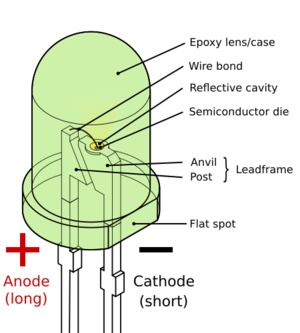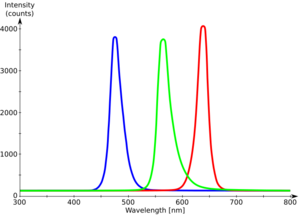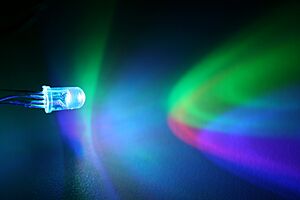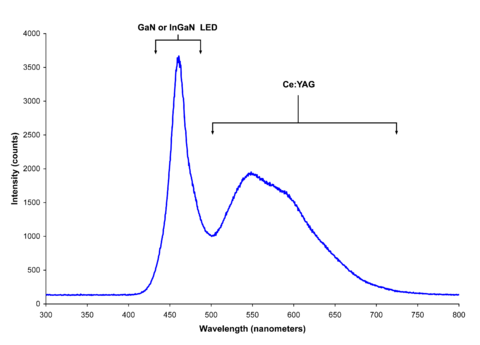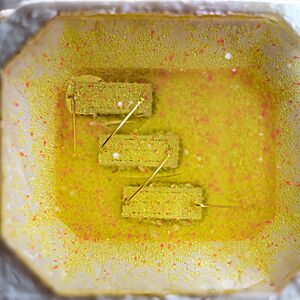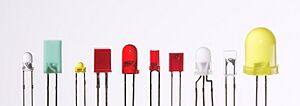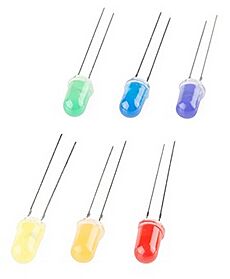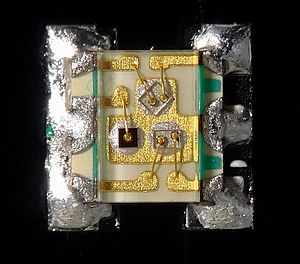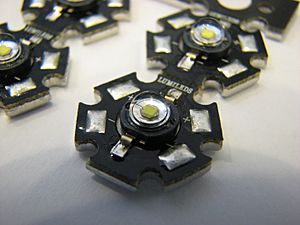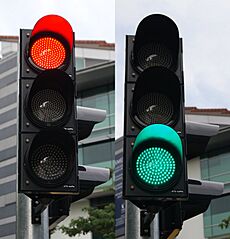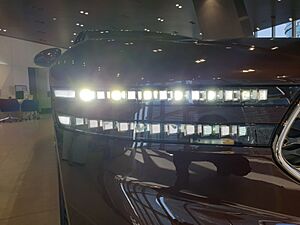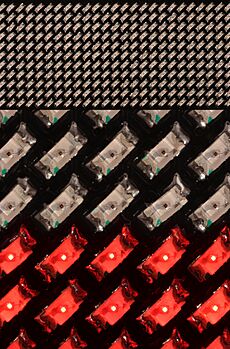Light-emitting diode facts for kids
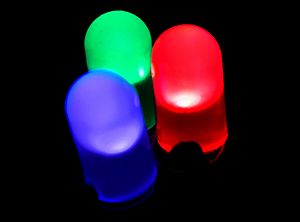
Blue, green, and red LEDs in 5 mm diffused cases. There are many different types of LEDs.
|
|
| Working principle | Electroluminescence |
|---|---|
| First production | October 1962 |
| Pin configuration | Anode and cathode |
| Electronic symbol | |
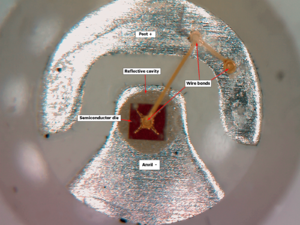
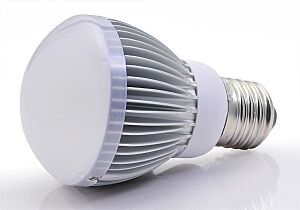
A light-emitting diode (LED) is a special electronic part that creates light when electricity flows through it. Inside an LED, tiny particles called electrons meet with "holes" (places where electrons should be). When they meet, they release energy as photons, which are tiny packets of light. The type of material used in the LED decides the color of the light it makes. To make white light, LEDs often use several materials or a special coating called phosphor.
LEDs first became useful electronic parts in 1962. The very first ones made infrared (IR) light, which we can't see. These were used in things like TV remote controls. Soon after, red LEDs that we could see became available, though they weren't very bright at first.
Over time, LEDs got much better. They started as small indicator lights, replacing old-fashioned tiny light bulbs. They were also used in simple number displays. Today, LEDs can make light in many colors, including visible light, ultraviolet (UV) light, and infrared. They can be very bright, bright enough for room lighting or even outdoor lights. LEDs are now used in countless ways, from traffic signals and car headlights to holiday decorations and lights for growing plants.
LEDs have many benefits compared to older light sources like incandescent bulbs. They use less electricity, last much longer, are tougher, and can be very small. They also turn on and off very quickly. However, LEDs usually need low voltage and DC power, not AC power directly from a wall socket. They also need to stay cool to work best and last long.
LEDs are like tiny machines that turn electricity into light. They do the opposite of photodiodes, which turn light into electricity.
Contents
A Brief History of LEDs
The idea of making light from a solid material, called Electroluminescence, was first noticed in 1906 by H. J. Round. He saw that certain crystals could glow with different colors when electricity passed through them.
Later, in 1927, a scientist named Oleg Losev in the Soviet Union made a basic LED using a material called silicon carbide.
However, it wasn't until 1962 that LEDs became truly useful. Engineers at Texas Instruments created LEDs that could efficiently produce infrared light. At first, these LEDs were very expensive. By the 1970s, companies like Monsanto and Hewlett-Packard helped make them much cheaper, costing less than five cents each. This made them practical for everyday use.
A big breakthrough happened in the early 1990s. Scientists Shuji Nakamura, Hiroshi Amano, and Isamu Akasaki developed blue LEDs. This was a huge step because it allowed for the creation of white LED lights and full-color LED screens. For their important work, they were awarded the 2014 Nobel Prize in Physics.
How LEDs Make Light
Inside an LED, there's a special material called a semiconductor. When electricity flows through it, tiny particles called electrons move around. These electrons meet with "holes" (which are like empty spaces where electrons should be). When an electron fills a hole, it releases energy. This energy comes out as a tiny flash of light, called a photon. This process is known as electroluminescence.
The color of the light an LED produces depends on the type of semiconductor material used. Different materials have different "energy gaps," which decide how much energy the electrons release. This energy then determines the wavelength of the light, which we see as color.
LED light is different from laser light. LED light spreads out more and isn't as perfectly focused or as strong as a laser beam. However, the light from an LED is usually a very clear, pure color to our eyes.
Types of LEDs
Single-Color LEDs
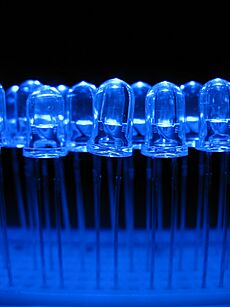
LEDs can be made to produce light in a single, specific color. This is done by choosing different semiconductor materials for the LED. These materials can create light from infrared (which we can't see) all the way through the colors we can see (like red, green, and blue) and into ultraviolet (UV) light (also invisible to us).
For example, blue LEDs are made using materials like indium gallium nitride (InGaN). By changing the mix of these materials, scientists can fine-tune the color of the light.
UV LEDs are used for special purposes. Some UV LEDs act like black lights, helping to check for hidden security marks on money. Other, stronger UV LEDs are used for hardening special glues or for killing germs because certain UV light can damage the DNA of tiny organisms.
White LEDs
There are two main ways to make white LEDs.
How RGB LEDs Make White Light
One way is to combine three separate LEDs: red, green, and blue (RGB). By mixing these three primary colors in different amounts, you can create white light or almost any other color. This method is very flexible for changing colors. However, it can be tricky to make the white light look perfectly balanced from every angle.
Phosphor-Based White LEDs
The more common way to make white LEDs is to use a blue or UV LED and cover it with a special material called phosphor. This phosphor absorbs some of the blue or UV light and then glows with a different color, usually yellow. When the blue light from the LED mixes with the yellow light from the phosphor, our eyes see it as white light. This is similar to how fluorescent lamps work.
The 'whiteness' of the light can be adjusted. Sometimes, different phosphors are mixed to create a warmer or cooler white light. This affects how colors look under the LED light. For example, some white LEDs might make red objects look less vibrant than they would in natural sunlight.
These phosphor-based LEDs are popular because they are simpler and cheaper to make than RGB systems. Scientists are always working to make these phosphors even more efficient and better at showing true colors.
Organic LEDs (OLEDs)
OLEDs are a special type of LED where the light-emitting material is made from organic compounds (materials that contain carbon). These organic materials are very thin and can be flexible.
OLEDs have many exciting uses. They can create very thin, lightweight, and flexible screens for things like cellphones, digital cameras, and televisions. They offer great colors and wide viewing angles.
Different Shapes and Sizes
LEDs come in many different shapes and sizes for various jobs.
Miniature LEDs
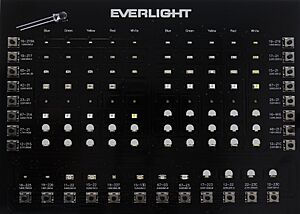
These are usually small, single LEDs used as indicator lights on electronic devices. They can be very tiny, from less than 2 mm to 10 mm across. They are often found on circuit boards or in flexible LED strips used for decoration. Some miniature LEDs even have a built-in resistor so they can be connected directly to a 5V or 12V power supply.
High-Power LEDs
High-power LEDs are much brighter and stronger than miniature ones. They can handle more electricity and produce a lot more light, sometimes over a thousand lumens (a measure of brightness). Because they produce more light, they also create more heat. So, they must be attached to a heat sink to cool them down, otherwise they can get damaged very quickly. These powerful LEDs are used in things like flashlights or in large arrays for bright LED lamps.
AC-Driven LEDs
Some special LEDs can work directly with AC power, like the electricity from your wall socket, without needing a separate converter. This makes them simpler to use in some lighting products.
LED Strip Lights
LED strip lights are flexible circuit boards with many LEDs attached. They come in various types, with different LED sizes, spacing, and color options. They are popular for decorative lighting and accent lighting.
Why Use LEDs?
LEDs offer many benefits that make them a popular choice for lighting and other uses.
- Efficiency: LEDs use much less electricity than old-fashioned light bulbs to produce the same amount of light. This saves energy and money.
- Size: LEDs can be made incredibly small, which allows them to be used in tiny devices or arranged in creative ways.
- Durability: Since LEDs are solid-state components (meaning they don't have fragile filaments or glass tubes), they are much tougher and more resistant to shocks and vibrations than traditional bulbs.
- Long Lifetime: LEDs can last a very long time, often tens of thousands of hours. This means you don't have to replace them as often as other lights.
- Fast Switching: LEDs turn on and off almost instantly, in microseconds. This is useful for communication and for things like car brake lights, where a quick response is important.
- Cool Light: LEDs produce very little heat in the form of infrared light. This means they don't heat up the objects they shine on, which is good for sensitive items.
- Color: LEDs can produce light in a specific color without needing filters, making them more efficient.
Powering LEDs Safely
LEDs are sensitive to electricity. They need a specific voltage to turn on and a controlled amount of current to prevent damage. If too much current flows through an LED, it can burn out quickly. Because of this, LEDs usually need special circuits or resistors to manage the electricity they receive.
LED Colors and Materials
LEDs are made from different inorganic semiconductor materials. Here's a simple table showing some common colors, the voltage they typically need, and the materials used:
| Color | Wavelength (nm) | Voltage (V) | Semiconductor material |
|---|---|---|---|
| Infrared | λ > 760 | ΔV < 1.9 | Gallium arsenide (GaAs) |
| Red | 610 < λ < 760 | 1.63 < ΔV < 2.03 | Aluminium gallium arsenide (AlGaAs) |
| Orange | 590 < λ < 610 | 2.03 < ΔV < 2.10 | Gallium arsenide phosphide (GaAsP) |
| Yellow | 570 < λ < 590 | 2.10 < ΔV < 2.18 | Gallium arsenide phosphide (GaAsP) |
| Green | 500 < λ < 570 | 1.9 < ΔV < 4.0 | Indium gallium nitride (InGaN) / Gallium(III) nitride (GaN) |
| Blue | 450 < λ < 500 | 2.48 < ΔV < 3.7 | Indium gallium nitride (InGaN) |
| Violet | 400 < λ < 450 | 2.76 < ΔV < 4.0 | Indium gallium nitride (InGaN) |
| Ultraviolet | λ < 400 | 3.1 < ΔV < 4.4 | Aluminium gallium nitride (AlGaN) |
| White | Broad spectrum | 2.7 < ΔV < 3.5 | Blue diode with yellow phosphor |
Where Are LEDs Used?
LEDs are used in countless ways because they are so versatile.
Lights and Indicators
LEDs are perfect for indicator lights on electronics, like the power light on your computer. They are also used in large displays at stadiums, on highway signs, and at airports and train stations to show information.
Traffic lights, exit signs, and emergency vehicle lights all use LEDs because they are bright and easy to see. Car brake lights and turn signals also use LEDs. They light up faster than old bulbs, giving drivers behind you more time to react, which makes roads safer.
Lighting Our Homes and Cities

High-efficiency LEDs are now widely used for general lighting. LED light bulbs save a lot of energy compared to older bulbs. They are used in homes, offices, and even for LED street lights. The Italian village of Torraca was one of the first places to switch all its streetlights to LEDs in 2007.
LEDs are also used in car headlights, bicycle lights, and even in the cabin lighting of modern airplanes. They are also used to backlight the screens of many LCD televisions, computer monitors, and phones, making them thinner and more colorful.
Because they are small and durable, LEDs are great for flashlights and camera flashes. They are also used for infrared lighting in night vision cameras.
Sending Information with Light
LEDs can turn on and off millions of times per second, which makes them great for sending information.
- Remote Controls: Many remote controls use infrared LEDs to send signals to your TV or other devices.
- Fiber Optics: LEDs are used to send data through fiber optic cables, which are essential for the internet and other high-speed communication.
- Visible Light Communication (VLC): Scientists are exploring using visible light from LEDs to transmit data, creating a new way to communicate without using radio waves.
Helping Machines See
Machines that "see" often use LEDs as their light source. Barcode scanners use red LEDs to read product codes. Optical computer mice use LEDs to track movement. LEDs are reliable and can be controlled precisely to light up exactly what a machine needs to see.
Science and Health Uses

LEDs have many uses in science and health.
- Plant Growth: Grow lights use LEDs to help plants grow better by providing the perfect light spectrum for photosynthesis. This is very useful in indoor farming.
- Sterilization: UV LEDs can be used to kill bacteria and viruses in water, air, and on surfaces.
- Medical Treatments: LEDs of specific colors are used in light therapy for conditions like neonatal jaundice (yellow skin in newborns) and acne.
- Sensors: The Nintendo Wii's sensor bar uses infrared LEDs. Pulse oximeters, which measure oxygen in your blood, also use LEDs.
Looking to the Future of LEDs
Scientists and engineers are always working to make LEDs even better.
One big challenge is to make LEDs more efficient, especially at higher power levels. They are also trying to improve the phosphor materials used in white LEDs so they can produce more accurate colors and last even longer.
New types of LEDs are being developed, such as those based on materials called perovskites. These perovskite LEDs (PLEDs) show great promise for being very efficient and potentially much cheaper to make, especially for large lighting areas. Researchers are making rapid progress in improving their brightness and efficiency.
Important Things to Know About LEDs
Health and Safety
While LEDs are generally safe, some very bright blue or cool-white LEDs can emit a lot of blue light. It's important to use them safely and avoid staring directly into very bright LED sources, especially for long periods. Eye safety standards help guide how these lights should be used.
LEDs do not contain mercury, which is a harmful chemical found in some fluorescent lamps. However, some LEDs may contain other metals like lead or arsenic, so they should be recycled properly.
In 2016, the American Medical Association (AMA) discussed how bluish street lighting might affect people's sleep patterns. However, many experts believe that normal exposure levels are not high enough to cause significant problems.
Environmental Issues
- Light Pollution: White LEDs can sometimes contribute more to sky glow (light pollution in the night sky) than older types of streetlights because they emit more blue light.
- Impact on Wildlife: LEDs can attract insects more than other lights, which could potentially affect food webs. Also, bright blue and white LED lights near beaches can confuse baby sea turtles, making them wander away from the ocean. Special "turtle-safe" LEDs that emit only specific colors are encouraged in these areas.
- Winter Conditions: Unlike incandescent bulbs, LEDs produce very little heat from their light-emitting surface. In cold, snowy conditions, this means snow can build up on LED traffic lights and obscure them, which can be a safety concern.
See also
 In Spanish: Led para niños
In Spanish: Led para niños
- High-CRI LED lighting
- Hiroshi Amano
- Isamu Akasaki
- LED Strip Light
- MicroLED
- Perovskite light-emitting diode
- Shuji Nakamura
- Superluminescent diode


